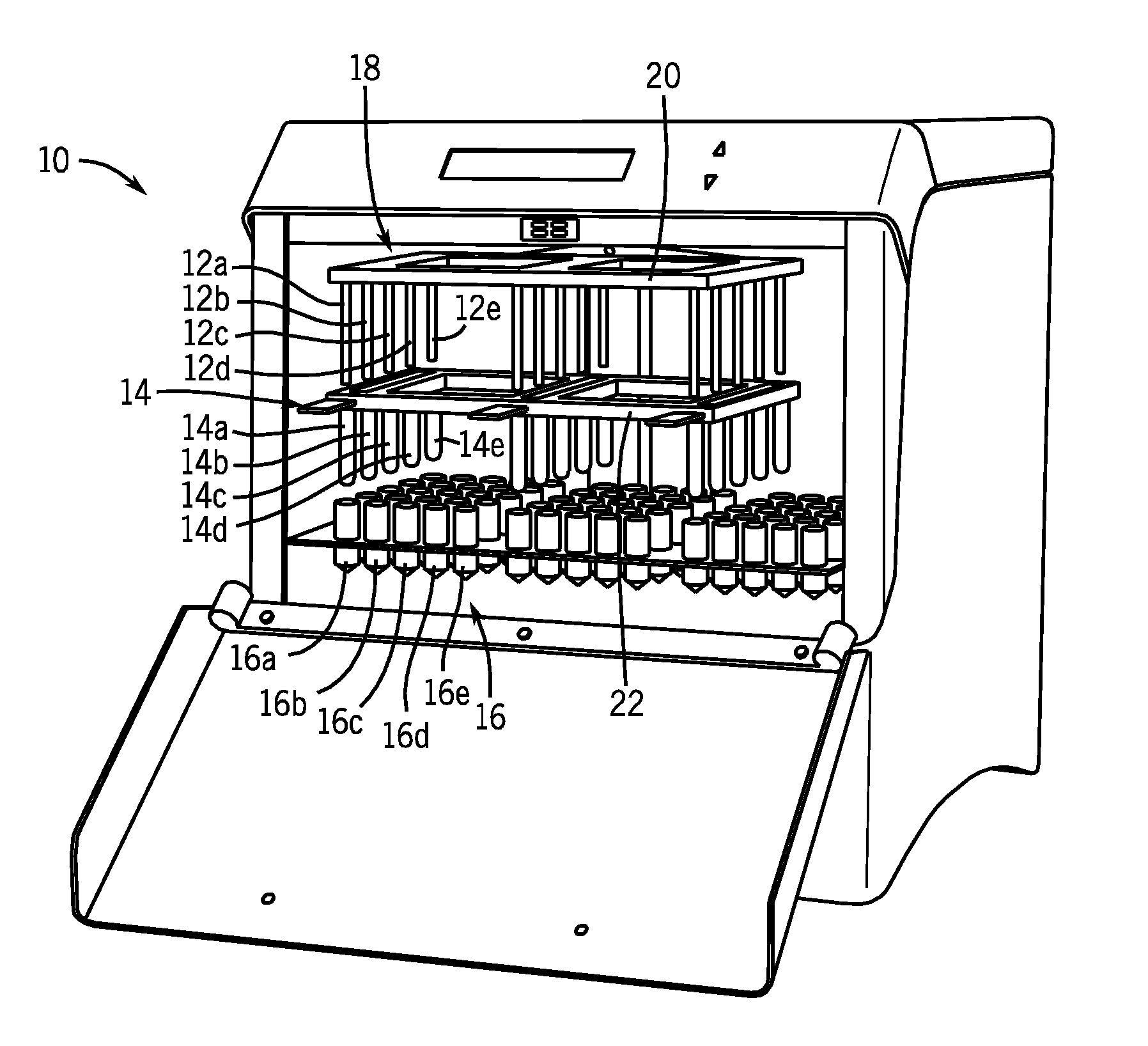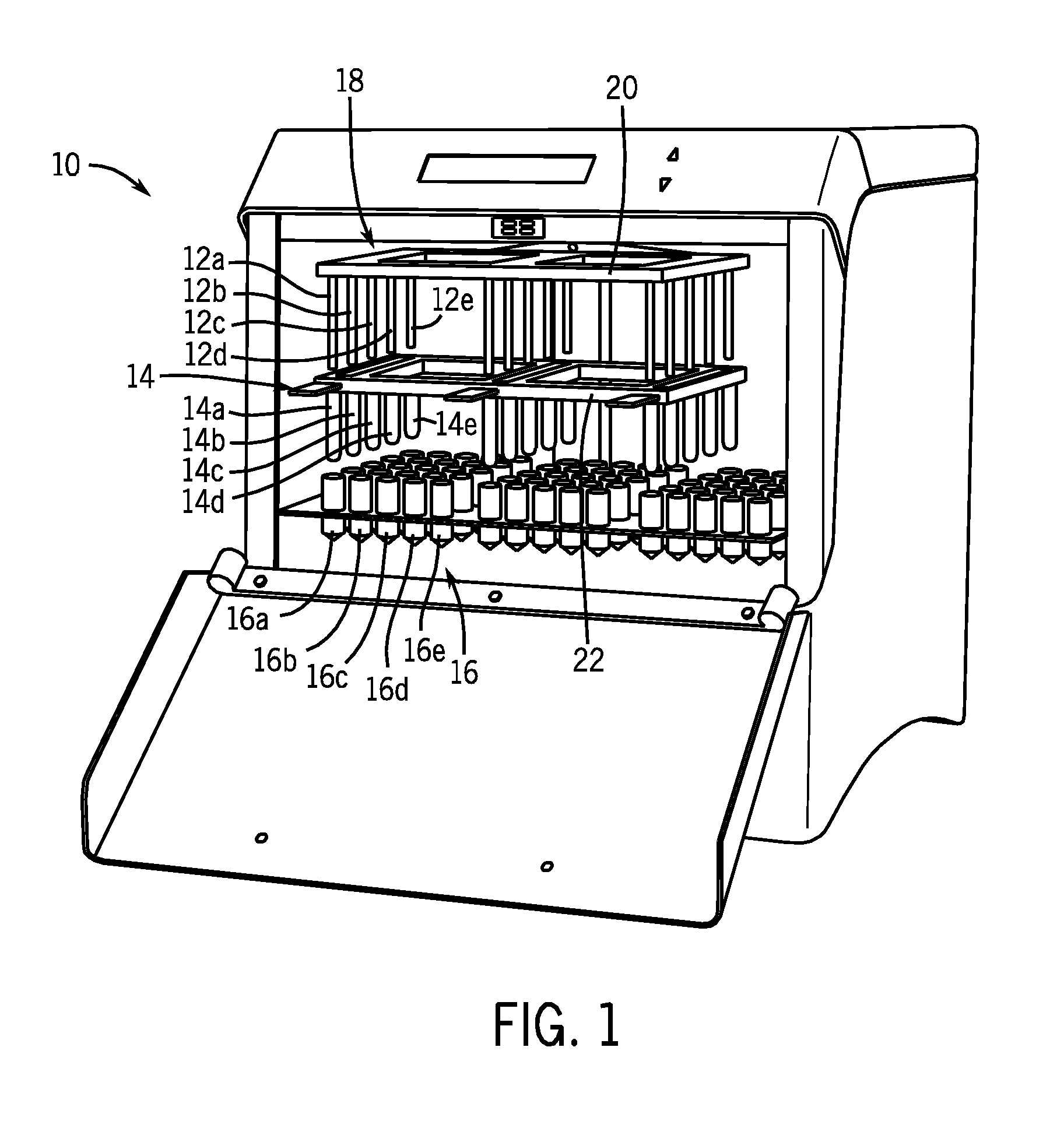Method of performing ultra-sensitive immunoassays
a technology of immunoassay and ultra-sensitive, applied in the field of immunoassay, can solve the problems of limited detection sensitivity of automated immunoassay analyzers, labor-intensive nucleic acid testing, and long time-consuming, so as to improve the specificity of assay, and improve the sensitivity of immunoassay
- Summary
- Abstract
- Description
- Claims
- Application Information
AI Technical Summary
Benefits of technology
Problems solved by technology
Method used
Image
Examples
examples
[0077]In these examples, the term “SPSP-Acr-115B-151423” means a conjugate comprising the anti-HIV-1 p24 monoclonal antibody 115B-151423 and N10-(3-sulfopropyl)-N-(3-sulfopropyl)-acridinium-9-carboxamide. The monoclonal antibody 115B-151423 is a monoclonal antibody specific for the HIV-1 p24 antigen. The term “CPSP-Acr-115B-151423” means a conjugate comprising the anti-HIV-1 p24 monoclonal antibody 115B-151-423 and N10-(3-sulfopropyl)-N-(3-carboxypropyl)-acridinium-9-carboxamide. The term “anti-HIV-1 p24 monoclonal antibody 120A-270-1068” means a monoclonal specific for the HIV-1 p24 antigen. The term “anti-HIV-1 p24 monoclonal antibody 108-394470” means a monoclonal antibody specific for the HIV-1 p24 antigen.
[0078]In these examples, products having the trademarks ARCHITECT® and PRISMS are commercially available from Abbott Laboratories, Abbott Park, Ill.
[0079]The following preparatory examples illustrate the preparation of magnetic particles containing the anti-HIV-1 p24 monoclona...
preparation b
[0109]The following materials were used to prepare the SPSP-Acr-115B-151-423 conjugate comprising the anti-HIV-1 p24 monoclonal antibody 115B-151-423 and an acridinium label:[0110]1. Stock solution of the anti-HIV-1 p24 monoclonal antibody 115B-151-423 (9.7 mg / mL in 10 mM phosphate buffered saline, pH 7.25)[0111]2. Pentfluorophenyl ester derivatized from N10-(3-sulfopropyl)-N-(3-sulfopropyl)-acridinium-9-carboxamide in dimethyl formamide (46.6 mM of the active ester in dimethyl formamide solvent)[0112]3. HPLC grade water[0113]4. Buffer solution, pH 4.0[0114]5. Buffer solution, pH 7.0[0115]6. Buffer solution, pH 10.0[0116]7. NaCl (1.0M)[0117]8. NaOH (1.0 N)[0118]9. NaOH (6.0 N)[0119]10. Na2HPO4.7H2O[0120]11. NaH2PO4.H2O[0121]12. NaCl[0122]13. 3-[(3-cholamidopropyl)-dimethylammonio]-1-propanesulfonate (CHAPS)[0123]14. CHAPS (0.1% CHAPS in phosphate buffered saline, pH 6.3)[0124]15. Sodium phosphate buffer (0.1 M, 150 mM NaCl, pH 8.0)[0125]16. Sodium phosphate buffer (1 M, 150 mM NaCl,...
example 1
[0134]This example illustrates how relatively large samples (1 mL) having a concentration of HIV-1 p24 antigen of lower than 1 pg / mL (0.2 pg / mL and 0.5 pg / mL) can produce a signal similar to that produced by using relatively small samples (0.1 mL) having concentrations of 2 pg / mL and 5 pg / mL when tested with the CPSP-Acr-115B-151-423 conjugate and magnetic particles coated with the anti-HIV-1 p24 monoclonal antibody 108-394-470 by means of magnetic particle processing.
The following materials were used in this example.[0135]1. Magnetic microparticles coated with the anti-HIV-1 p24 monoclonal antibody 108-394470. The magnetic microparticles were diluted to 0.2% solids in microparticle diluent.[0136]2. CPSP-Acr-115B-151-423 conjugate[0137]3. PRISM® HIVAG transfer wash buffer[0138]4. PRISM® HIVAG conjugate wash buffer[0139]5. Normal human plasma as negative control[0140]6. HIV-1 p24 antigen stock (526 pg / mL) diluted with normal human plasma to make diluted samples of HIV-1 p24 antigen a...
PUM
| Property | Measurement | Unit |
|---|---|---|
| volume | aaaaa | aaaaa |
| volume | aaaaa | aaaaa |
| volume | aaaaa | aaaaa |
Abstract
Description
Claims
Application Information
 Login to View More
Login to View More - R&D
- Intellectual Property
- Life Sciences
- Materials
- Tech Scout
- Unparalleled Data Quality
- Higher Quality Content
- 60% Fewer Hallucinations
Browse by: Latest US Patents, China's latest patents, Technical Efficacy Thesaurus, Application Domain, Technology Topic, Popular Technical Reports.
© 2025 PatSnap. All rights reserved.Legal|Privacy policy|Modern Slavery Act Transparency Statement|Sitemap|About US| Contact US: help@patsnap.com



